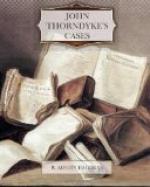“Then his remarkable skill in handling the powerful caretaker—a retired police-sergeant—suggested the Japanese art of ju-jitsu, while the nature of the robbery was consistent with the value set by the Japanese on works of art. Finally, the fact that only a particular collection was taken, suggested a special, and probably national, character in the things stolen, while their portability—you will remember that goods of the value of from eight to twelve thousand pounds were taken away in two hand-packages—was much more consistent with Japanese than Chinese works, of which the latter tend rather to be bulky and ponderous. Still, it was nothing but a bare hypothesis until we had seen Futashima—and, indeed, is no more now. I may, after all, be entirely mistaken.”
He was not, however; and at this moment there reposes in my drawing-room an ancient netsuke, which came as a thank-offering from Mr. Isaac Loewe on the recovery of the booty from a back room in No. 13, Birket Street, Limehouse. The treasure, of course, was given in the first place to Thorndyke, but transferred by him to my wife on the pretence that but for my suggestion of shell-dust the robber would never have been traced. Which is, on the face of it, preposterous.
IV
THE BLUE SEQUIN
Thorndyke stood looking up and down the platform with anxiety that increased as the time drew near for the departure of the train.
“This is very unfortunate,” he said, reluctantly stepping into an empty smoking compartment as the guard executed a flourish with his green flag. “I am afraid we have missed our friend.” He closed the door, and, as the train began to move, thrust his head out of the window.
“Now I wonder if that will be he,” he continued. “If so, he has caught the train by the skin of his teeth, and is now in one of the rear compartments.”
The subject of Thorndyke’s speculations was Mr. Edward Stopford, of the firm of Stopford and Myers, of Portugal Street, solicitors, and his connection with us at present arose out of a telegram that had reached our chambers on the preceding evening. It was reply-paid, and ran thus:
“Can you come
here to-morrow to direct defence? Important case.
All
costs undertaken by
us.—STOPFORD AND MYERS.”
Thorndyke’s reply had been in the affirmative, and early on this present morning a further telegram—evidently posted overnight—had been delivered:
“Shall leave for
Woldhurst by 8.25 from Charing Cross. Will call
for you if possible.—EDWARD
STOPFORD.”
He had not called, however, and, since he was unknown personally to us both, we could not judge whether or not he had been among the passengers on the platform.
“It is most unfortunate,” Thorndyke repeated, “for it deprives us of that preliminary consideration of the case which is so invaluable.” He filled his pipe thoughtfully, and, having made a fruitless inspection of the platform at London Bridge, took up the paper that he had bought at the bookstall, and began to turn over the leaves, running his eye quickly down the columns, unmindful of the journalistic baits in paragraph or article.




